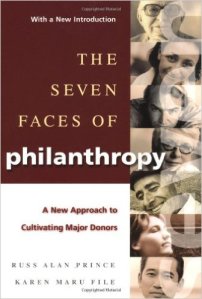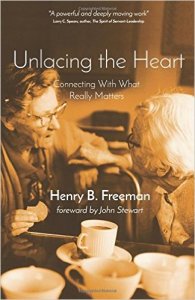As most of you know, DonorDreams blog has dedicated the first Thursday of every month for almost the last year to featuring a short video from Henry Freeman, who is an accomplished non-profit and fundraising professional. We affectionately call this monthly series “Hangin’ With Henry” because of the conversational format around which he has framed his online videos. This month we’re talking about Heart vs. Head Fundraising. I guess it only seemed appropriate with Valentine’s Day less than two weeks from now.
For those of you who subscribe to DonorDreams blog and get notices by email, you will want to click this link to view this month’s featured YouTube video. If you got here via your web browser, then you can click on the video graphic below.
https://www.youtube.com/watch?v=BfbjvnchuX4
I hope you enjoyed this month’s featured video. I not only enjoyed it. I loved it! Here were a few ah-ha moments I walked away with:
- I was reminded that donors are like snowflakes and each one is very different (which is the essence of donor-centered fundraising, right?).
- Good fundraising professionals can recognize this truism and adapt their approach when it comes to cultivation, solicitation and stewardship.
- Just like how different donors are motivated by different head vs. heart messages, there are different types of fundraising professionals who are better at one or the other approaches.
When I worked for Boys & Girls Clubs of America as an internal consultant, my toolbox contained a PowerPoint training they called “Closing the Gift“. It was contained the organization’s teachable point of view for how staff and volunteers at local affiliates should go about soliciting donors. This process included 12 steps that volunteers were encouraged to follow. Doing so would minimize the fears associated with asking for money and maximize the effectiveness of the solicitation.
Here are those 12 steps:
- Make your gift first
- Think about the kids (in order words, stop obsessing and thinking about the money and start thinking about why you are doing this)
- Choose good prospects to solicit (aka no cold calls)
- Pick-up the phone and schedule the in-person meeting
- Prepare for the meeting
- Talk about the kids (aka discuss the case for support)
- Share your commitment
- Ask the donor to “consider” a specific gift amount
- After making the ask, BE QUIET
- Answer questions
- Schedule date/time to “follow-up” if they needed time to think about it (aka don’t leave the pledge card behind and schedule time to circle back to complete paperwork)
- Express gratitude for their time and consideration
Over the last 10 years, I’ve made a lot of money working with clients on this 12-step program. LOL It might look easy, but as people always say . . . “The devil is in the details“. 😉
However, while “Hangin’ with Henry” this morning and listening to his thoughts about heart vs. head fundraising, I was reminded of something new to which I’ve recently been exposed with regards to making the ask.
Last month, I was onsite with a capital campaign client and I needed to train a group of volunteers on how to make an effective, “by the book” solicitation. Rather than reach in my toolbox for my standard training curriculum, I was allowed access to another fundraising professional’s toolbox.
 While much of the process was the same, this new training incorporated some of the ideas put forth in the book “The Seven Faces of Philanthropy: A New Approach to Cultivating Major Donors” written by Russ Alan Price and Karen Maru File. In a nutshell, the book identifies and profiles seven types of major donors and offers detailed strategies on how to approach them.
While much of the process was the same, this new training incorporated some of the ideas put forth in the book “The Seven Faces of Philanthropy: A New Approach to Cultivating Major Donors” written by Russ Alan Price and Karen Maru File. In a nutshell, the book identifies and profiles seven types of major donors and offers detailed strategies on how to approach them.
The following are the seven different “types of donors” identified and profiled:
- The Communitarian
- Devout
- Investor
- Socialite
- Altruist
- Repayer
- Dynast
I won’t give away anymore of what characterizes these seven groups or the strategies they suggest you use to approach each type of donor because I suspect the authors would like you to buy their book. 🙂 If you are in the market for good professional reading, I highly recommend this book.
So, as I listened to Henry and Joan chatter about heart vs. head fundraising this morning, I found my thoughts drifting back to the training session I facilitated last month.
Some of the volunteers around the table LOVED the “seven types of donors” wrinkle and other volunteers absolutely HATED the idea and preferred the simpler 12-step approach.
This got me thinking.
Henry said in the video that there are “heart donors” and “head donors“. He also said there are fundraising professionals who are more adept with each approach. After my experience last month, I would apply this thinking to fundraising volunteers, too.
As I get to the bottom of my cup of coffee this morning, I am left with the following questions:
- Are you a heart fundraiser or head fundraiser?
- After identifying which type of donor you’re dealing with, are you capturing it in your donor database or CRM?
- When recruiting fundraising volunteers, are you using this “heart vs. head” lens to develop a diverse prospect list? Are you also using this lens as part of your prospect assignment exercise?
As I always say, we can all learn from each other. Please scroll down and share your thoughts and experiences (or take a crack at answering any of the aforementioned questions) in the comment box.
Here’s to your health!
Erik Anderson
Founder & President, The Healthy Non-Profit LLC
www.thehealthynonprofit.com
erik@thehealthynonprofit.com
http://twitter.com/#!/eanderson847
http://www.facebook.com/eanderson847
http://www.linkedin.com/in/erikanderson847


 For those who are curious, here are those 12 steps to a simple and effective face-to-face solicitation:
For those who are curious, here are those 12 steps to a simple and effective face-to-face solicitation: This morning’s video also reminded me of another YouTube video a friend sent me a few days ago. It is a montage of video clips featuring actor Matt Damon in the HBO television series “Entourage“. The YouTube video illustrates the emotions, fears, and mistakes associated with asking your friends and colleagues for a charitable contribution.
This morning’s video also reminded me of another YouTube video a friend sent me a few days ago. It is a montage of video clips featuring actor Matt Damon in the HBO television series “Entourage“. The YouTube video illustrates the emotions, fears, and mistakes associated with asking your friends and colleagues for a charitable contribution.

